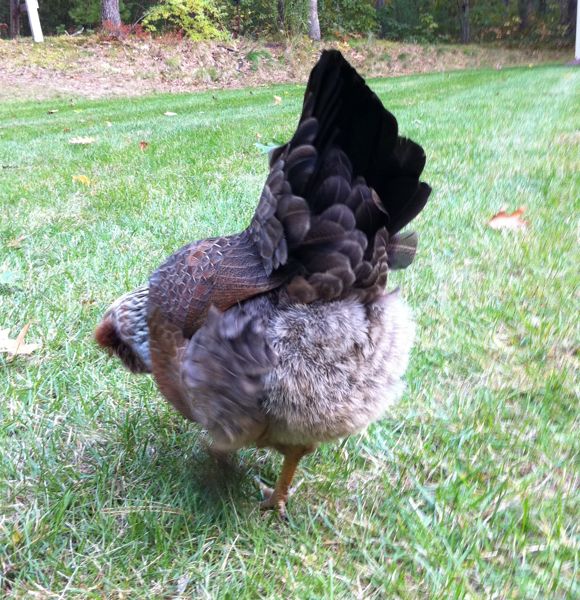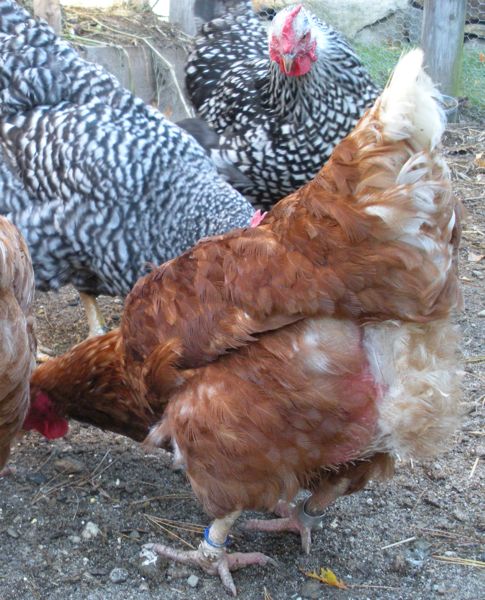Here at HenCam, just about the most asked about topic is about feather loss. Right now it’s molting season, when usually calm hen owners email me in a panic because all of a sudden their hens look like worn-out toy stuffed animals. Rest assured that molting is normal, albeit messy.
I also get queries about hens with bare backs. That’s usually an easy one to answer. 99% of the time, there’s a rooster in with the hens. Roosters claw and pull out feathers during their frequent matings. Sometimes the rooster favors one hen, so her saddle feathers get worn off, while all of the other girls look lovely. If there are open wounds, or her skin is so red that the others peck at her, you’ll have to separate her, or get rid of the rooster.
Most of the feather loss questions, however, are about bare butts. All chickens have short, soft feathers near their vents. This hen (owned by my friend Sharon) has a classic bottom.
Don’t you just want to pat it? She’s a young bird, hatched in May. She’s only started to lay, and her owner overfeeds her (yes, Sharon, cut back on the corn!) so she’s in fine feather. She won’t molt until next year and there are no roosters about. She’ll never look better than she does now (well, she could go on a bit of a diet.)
My two-year old hens, Agnes and Philomena, are a sleeker breed and never had such gorgeous bottoms. But, lately, they’ve been looking rather ragged. They’re a hybrid, bred for egg laying production. They’ve laid every day for months. Feather loss can be a sign of a good layer. Caloric and nutritional intake goes into egg-making, and the feathers suffer. When Petunia is laying, her neck goes bald. Look at Agnes’s bottom. It’s red and bare. Not a pretty sight, but she’s perfectly healthy. (She’s also molting, so the butt feather loss is more noticeable.)
Sometimes, though, bare butts are a sign of parasites. If you see bare skin, always pick up your birds and examine them closely. (To learn how to do this, watch my youtube video.) A lice infestation is first seen near the vent. There will be bare skin and the feather shafts will look like Q-tips.
You might see the lice crawling about. I’ve written about lice here. (And also check the archives for more posts.)
Once in awhile, there will be a feather-picking hen in the group. You might never catch her in the act, but she’ll peck away at the other hens’ vent feathers, until, one day, you notice bare spots and possibly blood. My little Snowball, who was a cheerful, delightful hen, was a feather picker. Some say that a chicken feather picks to make up for a nutritional deficiency. It never hurts to make sure that your hens have access to dirt, minerals, and good feed with protein. However, that wasn’t the case with Snowball. She was active and bored, and discovered that when the big girls dust-bathed, she could move in, peck off the occasional parasite, pull some feathers, and have a good time. Fortunately, before this caused severe problems, the weather turned cold, the hens stopped sprawling in the sun, and Snowball gave up her bad habit.
Regardless of the cause, it’s a good idea to keep an eye on those bare patches of skin. If they’re raw and red, the other hens will peck at them and cause open wounds. It that looks to be a problem in your flock (some groups are more aggressive than others) you can darken the skin with blu-kote (similar to genetian violet in the UK.) It dyes the skin purplish-blue, so the hens don’t peck.
I was envious seeing Sharon’s fluffy-butten pullets. I’m ready for some young birds. I’ve already started my wish-list for a spring chick order.




Sharon’s bird looks very Dorking-ish to me! I must admit I let mine ‘pork up’ a bit when they’re moulting – they won’t lay again ’til spring so they’re fine a bit heavier, then in February or so I slim them down a bit so laying isn’t too much effort for them.
Gentian violet does indeed stain, my hands are currently purple after doing surgery on someone’s wattle!
Were there ever purple children when you were at school? Gentian violet used to be used for ringworm, the fungal skin infection, but possibly there are less stigmatising treatments now!
Not a dorking. She lays blue eggs. But quite pretty.
Amazingly, I my school didn’t have fungus or head lice! But, yes, I’ve learned to wear gloves with the blu-kote. I’ve also learned that the sprayer doesn’t always go the direction intended, and I’ve got purple stains on a jacket.
Yes… it is molting season. I have one chicken that looks like she went through the feather plucker backwards! LOL! I too am planning on my spring chicken order. Good Luck. :)
New girls? Now I’m excited. Not that I don’t adore your existing ones.
Terry! Do tell your “wish list’ when it is done! Nothing more fun than baby birds! Where did you decide to get them?
I know that I want a couple of new Orpingtons, a couple of blue egg layers and two RIR and a Dorking. I’d like to get them from one hatchery – want everyone exposed to the same germs and having had the same vaccinations. Any suggestions? I like Meyer, but they don’t have Dorkings.
Terry..What are Dorkings and what do you like about them? I am not familiar with this breed….D.
Dorkings are an ancient British breed. 5 toes. Beautiful greyish feathers. They do go broody, though, so I’m reconsidering them.
terry, I had emailed you about a year ago with this very problem! I did check for parasites and luckily had none but then again..why was I getting these terrible bare bums in my flock??!!! well, they never really grew back even though I tried everything and so I had given up hope. But, these past few months they have grown in!!! YAY! It has taken so long and we were so excited to see those little poky quills coming in! So that leads me to my question for you..I was told that when this situation happens they will only grow back in at a certain time of year. Have you heard this? And if you have..what about those that have yet to get anymore coming in? Not all have.
Marissa, your question pushed me to write this post :) I think that laying eggs is so depleting, that hens don’t put the energy into growing back their feathers until the fall, when sunlight decreases, the molt happens, and their bodies are geared for feather renewal.
Terry,
I could have sworn that My Pet Chicken had dorkings available one season, and they get their stock from Meyer. I think the availabilities vary by year, so you could check either place in the spring.
About the molting…I have one hen who’s molted three times in the last 12 months. I’m not sure what her deal is. My others all molted in the middle of July. The only thing I can can think of is all the strange weather.
My best layer, however, put off her first molt until she was almost two. A while leghorn mix. Some strange things going on here.
The leghorn mix not molting until two is normal enough, but a hen who’s molted three times? Are they three distinct molts, with full-feather grow backs, or is it that she never fully loses her feathers? I assume she’s not laying. Hens don’t lay when molting. Maybe she has some other issue and her feather loss is due to something else?